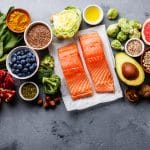– The importance of fiber in a healthy diet
– How fiber affects digestion and gut health
– The role of fiber in weight management and diabetes prevention
– The various sources of fiber and the unique properties of each
– Tips for incorporating more fiber into your diet
Fiber is an unsung hero in the world of nutrition. It often goes unnoticed, overshadowed by the glamour of trendy diets and quick fixes. However, this unnatural nutrient is powerful in maintaining a healthy body and preventing metabolic diseases. In this article, we will delve into the fascinating aspects of why fiber is essential for a healthy diet and explore its surprising benefits.
First and foremost, let us spotlight the importance of fiber in our daily lives. Humans consume various types of food, each with its unique nutritional value. However, some of these nutrients are not fully broken down and absorbed by our bodies. This is where fiber comes into play. It acts as a broom, sweeping away those unabsorbed components, thus aiding in proper digestion.
One of the fascinating ways fiber affects our bodies is through its impact on gut health. Within our digestive system resides trillions of microorganisms, collectively known as the gut microbiota. These microscopic warriors play a crucial role in our overall health and well-being. Interestingly, fiber is nourishing fuel for these beneficial bacteria, allowing them to thrive and carry out their essential functions. By supporting the growth of these microbial allies, fiber can help prevent gastrointestinal disorders, improve immune function, and even enhance mental health.
But the wonders of fiber do not stop there. IFiber can be your greatest ally if you’re on a journey to shed some extra pounds or maintain a healthy weight, Unlike other nutrients that provide calories, fiber is almost calorie-free. This means you can consume enough fiber-rich foods without worrying about packing the pounds. Furthermore, fiber-rich foods tend to be more filling, helping to curb those bothersome hunger pangs. It’s like having a natural appetite suppressant right at your fingertips!
Diabetes, a growing epidemic, is another area where fiber shines. Studies have shown that a high-fiber diet can significantly reduce the risk of developing type 2 diabetes. How does fiber achieve this remarkable feat? Well, it all comes down to its impact on blood sugar levels. When we consume foods high in fiber, they are digested and absorbed at a slower pace, leading to a gradual and steady release of glucose into the bloodstream. This prevents sugar spikes and helps regulate insulin levels, ultimately lowering the risk of insulin resistance and diabetes.
Now, let’s explore the various sources of fiber and their unique properties. Not all fibers are created equal, and it’s essential to diversify our sources to reap the maximum benefits. There are two main types of fiber: soluble and insoluble. As SAsthe name suggests, soluble fiber dissolves in water and forms a gel-like substance in the gut. It can be found in fats, legumes, and fruits. Soluble fiber helps lower cholesterol levels, reduce the risk of heart disease, and promote a healthy gut.
On the other hand, insoluble fiber adds bulk to our stools, aiding in regular bowel movements and preventing constipation. This type of fiber is present in foods like whole grains, vegetables, and nuts. By keeping our digestive system in top shape, insoluble fiber ensures the efficient elimination of waste materials, promoting a healthier gut environment.
Incorporating more fiber into your diet doesn’t have to be a chore. Here are some tips to make it an enjoyable journey:
1. Start slowly: If you’re new to a high-fiber diet, it’s best to introduce it gradually. Sudden drastic increases can cause bloating and discomfort. Begin by incorporating one fiber-rich food at a time and gradually increase your intake.
2. Choose whole foods: Instead of relying on processed foods that claim to be high in fiber, opt for whole foods. Fruits, vegetables, whole grains, and legumes are excellent soluble and insoluble fiber sources.
3. Get creative with your meals: Experiment with new recipes and add different types of fiber-rich foods to your dishes. Sprinkle chia seeds on your yogurt, toss some roasted chickpeas into your salad, or enjoy a hearty bowl of oatmeal for breakfast. The possibilities are endless!
4. Hydrate, hydrate, hydrate: Fiber absorbs water, so staying well-hydrated throughout the day. At least eight glasses of water or other hydrating fluids need to ensure the smooth passage of fiber through your digestive system.
In conclusion, fiber is a nutritional powerhouse that deserves more attention. It supports digestion, promotes a healthy gut, aids in weight management, and reduces the risk of metabolic diseases like diabetes. By incorporating fiber-rich foods into our diet, we can unlock these benefits and take control of our health. So, let’s raise a glass, or better yet, a spoonful of fiber, to good health and vibrant life!
*****
Source Description
Follow the Dr. Gundry Podcast:
youtube.com/@DrGundry
Are you getting enough fiber in your diet? In this clip from the Dr. Gundry Podcast, Dr. Steven Gundry explains why fiber is essential for maintaining a healthy gut and overall well-being. From reducing inflammation to promoting weight loss, fiber has numerous benefits you don’t want to miss Tune in to the Dr. Gundry Podcast to learn more about the latest health trends and tips from the experts. Don’t forget to like and subscribe for more great content!
———————-
Follow Gundry MD
👥Facebook: https://www.facebook.com/GundryMD
📸Instagram: https://www.instagram.com/gundrymd
📌Pinterest: https://www.pinterest.com/gundrymd
🎵TikTok: https://www.tiktok.com/@gundrymd
#GundryPodcast #WeightLoss #Nutrition


